-
 C- Reactive Protein
C- Reactive Protein C- Reactive Protein - Parameters: 1
The traditional acute phase protein for inflammatory responses is C-reactive protein. A substantial acute chase response of C-reactive protein (CRP) is linked to most tissue-damaging events, including infections, inflammatory disorders, and malignant neoplasms. Often, the CRP response occurs before clinical signs, such as fever.
-
 Erythrocyte Sedimentation Rate
Erythrocyte Sedimentation Rate Erythrocyte Sedimentation Rate - Parameters: 1
The Erythrocyte Sedimentation Rate (ESR) test measures the rate at which red blood cells settle in a tube of blood over time. It is a nonspecific indicator of inflammation in the body, with elevated rates suggesting the presence of inflammation or infection. Despite its nonspecificity, ESR is valuable in diagnosing and monitoring conditions like autoimmune diseases, infections, and certain cancers. Our laboratory provides accurate ESR testing to aid in timely diagnoses and effective treatment plans.
-
 Ferritin
Ferritin Ferritin - Parameters: 1
Ferritin is a macromolecule that has a molecular weight of at least 440 kD, depending on the amount of iron present. It is composed of an iron core that has an average of about 2500 Fe3+ ions (in liver and spleen ferritin) and a protein shell (apoferritin) with 24 subunits. Ferritin measurement is a useful technique for determining the state of iron metabolism. A representative measurement of the body's iron reserves can be obtained by measuring ferritin at the start of treatment. Early detection is possible when it comes to reticulo-endothelial system (RES) storage deficiencies.
-
 Full Blood Count
Full Blood Count Full Blood Count - Parameters: 1
Full Blood Count
-
 Glucose Fasting
Glucose Fasting Glucose Fasting - Parameters: 1
Glucose Fasting
-
 Lipid Profile
Lipid Profile Lipid Profile - Parameters: 6
Lipid Profile
-
 Liver Function
Liver Function Liver Function - Parameters: 8
Liver Function
-
 Renal Function
Renal Function Renal Function - Parameters: 6
Renal Function
-
 Vitamin D
Vitamin D Vitamin D - Parameters: 1
It takes vitamin D to maintain healthy bones. A severe deficit in youngsters causes rickets, a deformity of the bones. Less severe insufficiencies are thought to result in less effective dietary calcium utilisation. Muscle weakness results from a vitamin D shortage; in the elderly, this impact has been linked to an increased risk of falls. One common cause of secondary hyperparathyroidism is a vitamin D deficiency. PTH elevations can cause osteomalacia, accelerated bone turnover, decreased bone mass, and an increased risk of bone fractures, particularly in older vitamin D deficient persons. Reduced bone mineral density is also correlated with low amounts of vitamin D (25.OH). The findings could be helpful in evaluating bone metabolism when combined with further clinical information. Sunlight exposure is the primary source of vitamin D, a fat-soluble steroid hormone precursor that is generated in the skin. To produce the physiologically active 1,25-dihydroxyvitamin D, vitamin D must go through two consecutive hydroxylations in the liver and kidney. Vitamin D is biologically inactive. Since vitamin D (25-OH) is the primary form of vitamin D stored in the human body, it is widely accepted that this metabolite should be used to assess the overall status of vitamin D.










